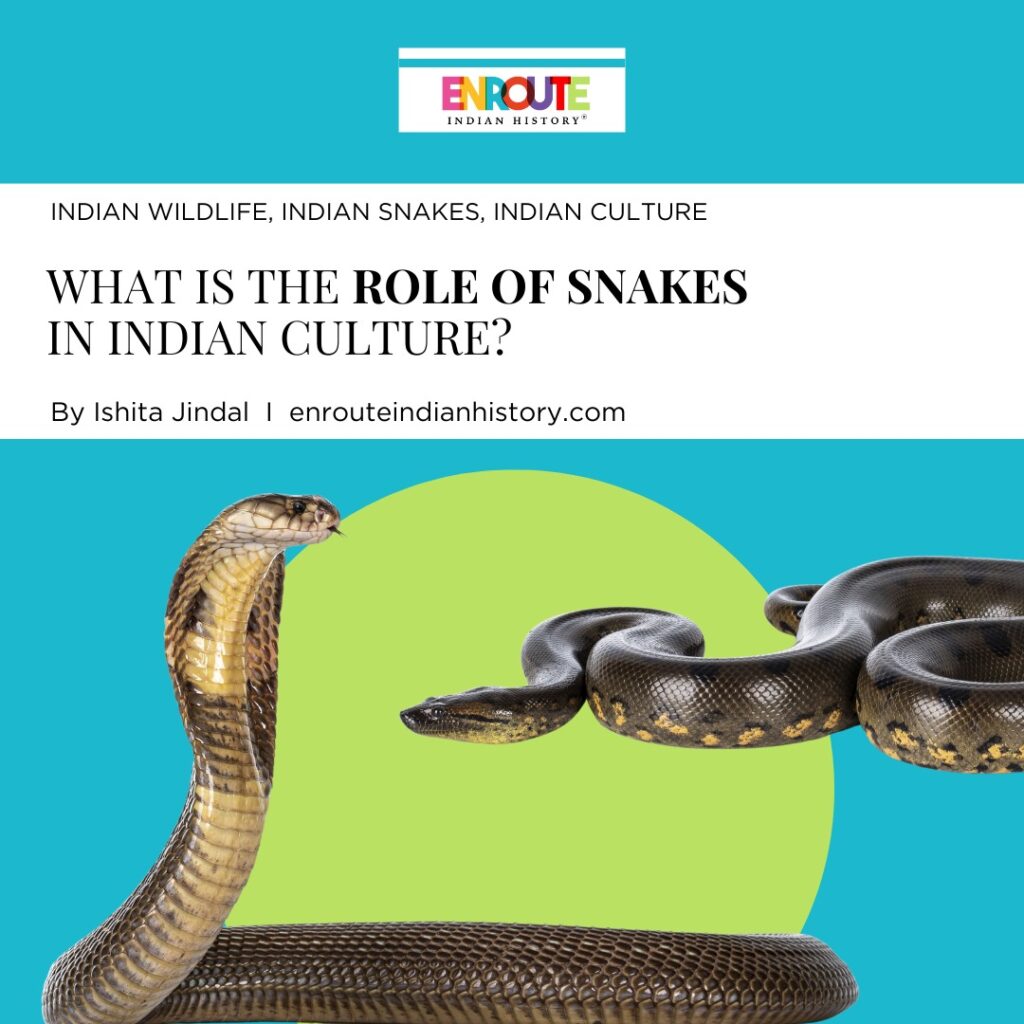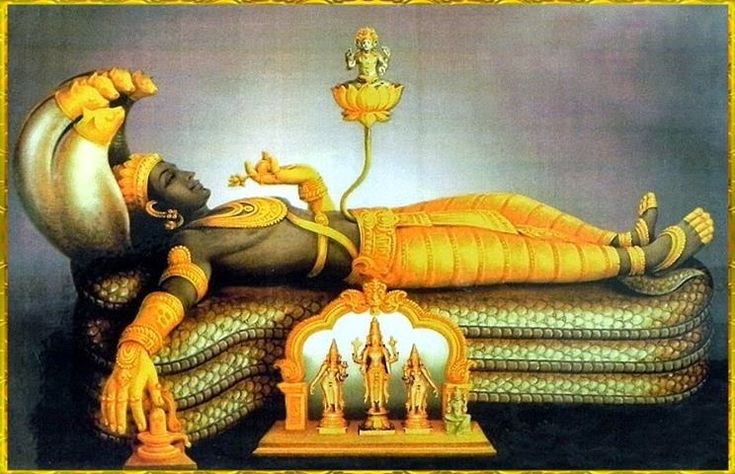
A significant part of Indian mythologies and cultural practices are snakes. Snakes are still given high esteem in Indian culture and their emblematic importance is visible in various Indian customs. The snake primarily represents reincarnation, death, and temporality. This is because of its ability to shed its skin and being a symbol of “reincarnation”. Etched impressions of cobras or “nagas” can be seen in numerous regions of India. In Hindu mythology, Snakes are associated with Lord Shiva. The snake is believed to be the most prominent part of the deity. The snake wrapped around Lord Shiva’s neck is referred to as Vasuki or Nagendra. The snake is the representation of perpetuity and divine knowledge. Lord Vishnu, another significant Hindu deity is also portrayed to be taking rest on a coiled serpent, Shesha Naga. A well celebrated Hindu festival honouring the snake deities is Naga Panchami. On this occasion, people worship the serpent deities and offer milk, flowers, and fruits. People seek blessings from the serpent deities to protect them from bites of snakes. In various Hindu folklores, snakes can often be seen to be safeguarding precious treasures or as protectors of holy shrines.
Common myths and intangible heritage
In India, myths surrounding snakes are very common, snakes are associated with cultural and religious beliefs. Snakes form an integral part of the Indian heritage and culture. The history of India indicates the existence of snake worship. It is essential to consider that the depiction of India as the realm of snake charmers is an excessive simplification of the diverse culture of India as it does not depict the entirety of its culture (Salunkhe, 2023). Surya Keerthi also known as the Snake Man of Mysore has been committed to disregarding these myths to preserve and protect the species of snake species. Snake charming is an intangible part of the heritage of India. This includes charming the snakes in response to music (Landry Yuan et al., 2020). Keerthi focuses on educating people about snakes and making people aware to be able to peacefully coexist with them.
Snake pooja in Indian homes
Snake worship is a very common practice in Indian households. Snakes are considered very auspicious in India owing to their relevance in the culture and religion of India. Every year on Nag panchami, the snakes are worshipped in Indian houses. The idol or image of the Nag/ snake that is worshipped is offered milk for bathing (Chandler, 2022). Besides the offering of milk for bathing, the idols are decorated with turmeric paste, vermillion, and also worshipped with incense sticks. Then a pooja is performed alongside the chanting of mantras that are required for offering prayers to the snakes.
Snakes in tribal stories
Several interesting stories surrounding snakes are popular in Indian folktales and stories of the tribals. The capability of the snakes to be able to shed its skin and evolve as a new entity has been related to themes of death, life, and rebirth. Snakes are popularly depicted as guardians of unknown treasures or protectors of holy places. A very popular tribal story about snakes is “The Mark of Vishnu” which explores the story of Gunga Ram and depicts the consequences of getting trapped into superstition and blind faith. In the tale, Gunga Ram, a worshipper of Vishnu has blind faith on the worship of snakes (Muhammed Maheen, 2020). The protagonist assumes that every animal, even the threatening ones, must be safeguarded. Consequently, the blind faith and ignorance of the protagonist results in a destructive ending. Khushwant Singh draws the relation between superstition and science in this story. In the process of focusing on Vishnu as a crucial Hindu god, the writer aims to depict the superstition and culture in the tale (Lopezalles, 2020). The protagonist of the story, Gunga Ram has been depicted as a devotee who has blind faith in the worship of Kala Nag. The story portrays a very important lesson that blind and illogical faith and superstition can lead to the fall of people as Gunga Ram suffers from the harmful consequences of his blind faith.
Nagas tribe and snake village in Maharashtra
In Maharashtra, the Nagas tribe is a separate community having a rich heritage of culture that is mainly confirmed based on their unique practices and traditions. This type of tribal group has significantly contributed to the cultural nature of the region and is mainly known for its historical practices. The Nagas tribe is generally famous for their traditional lifestyle and close relationship with nature which reflects a compatible occurrence with the surrounding environment (Salunkhe, 2023). On the other hand, Maharashtra is generally famous for its nature that helped to build the Snake Village, where the combination of reality and mythology becomes evident. This Snake village is reorganised based on its approval of snakes, considered dedicated beings in Hindu mythology. In Maharashtra, the residents of Snake Village (Shetphal) generally exist with these reptiles, providing a separate blend of regular and spiritual life. The custom of this village includes dynamic festivals and rituals dedicated to snakes, cultivating a sense of respect and unity between its inhabitants (Salunkhe, 2023). The Nagas tribe and Snake village both form an entrance of decoration of Maharstra’s cultural diversity, providing a glance into the symbiotic relationship among the natural worlds and communities in this lively Indian state.
Relevance of snakes in Hindu mythology
Snakes are considered extremely significant in Hindu mythology by the depiction of snakes in the various stories associated with snakes across India. The courageous, Bheem, in the Mahabharata, was blessed to witness the mystical appearance of the serpent deity that it had encountered. The story of “Lord Buddha” focused on the ability of snakes to provide protection as reflected in the incident of Buddha taking shelter underneath the naga shelter (Hopley, 2023).
Kadru, wife of Rishi Kashyap is believed to be the mother of Snakes. Hindu gods and goddesses are often associated with snakes that symbolise the divine force. “Vishnu, Shiva, and Maa Tara” are mainly associated with serpents (Jones, 2022). “Lord Vishnu”, a popular Hindu deity, is portrayed as sitting on a serpent, “Shesha”. “Lord Shiva” is popularly portrayed with a serpent wrapped around his neck, this serpent is called “Vasuki or Nagendra”.

Figure: Lord Vishnu resting on the serpent
(Source: Adapa, 2021)
The snake tale of Sri Aurobindo depicts the spiritual relationship between snakes and humans. It reflects the popular concept related to snakes being the protectors of wealth. The essential part played by snakes in sculpting the ancient tales is portrayed by the story of Rishi Kashyap. The story follows the encounter of Kashyapa and the serpent king, Takshaka, who had planned to kill the king of Parikshit (Adapa, 2021).

Figure: Seven-headed serpent over Patanjali
(Source: Adapa, 2021)
In the architecture of the “Belur Chennakeshvara Temple ” there is a depiction of snake goddesses. Snakes are worshipped in “Mannarasala Temple in Kerala”, specifically to improve the astrological flaws such as the “Jyotish Sarp Dosh” influencing the destinies of individuals. Patanjali while performing Yoga is popularly portrayed with a naga, focusing on the spiritual connection between snakes and humans. Tapkara in Chhattisgarh portrays the mythological creature that is half-human and half-snake figures. This signifies the relevance of the mystical tales related to snakes.
A precious and appealing gemstone associated with snakes is called the “Nagmani”. This gemstone is considered an essential part of Indian religion and culture. It is known to bring good fortune to people who possess it. People who possess this valuable gemstone can obtain excessive luck, money, and wealth (Mukherjee, 2021). The Hindu temples are known to often demonstrate images and carvings of snakes on the walls. This signifies the importance and prominent relevance of serpents in Hindu mythology.
Bibliography
Adapa, K., (2021). The Nagas, the seven-headed serpent, and migration to different parts of the world.
Chandler, K.E.D., (2022). Snake in the grove: an ecological exploration into the nexus of religious boundaries, environmental agency, and the goddess Manasā in the Sundarbans mangrove forest (Doctoral dissertation).
Hopley, C.C., (2023). Snakes: Curiosities and wonders of serpent life. Good Press.
Jones, D.T., (2022). The Tree, the Snake and the Goddess: Symbols of the Buddha’s Relationship with Nature. Worldviews: Global Religions, Culture, and Ecology, 27(1-2), pp.25-56.
Landry Yuan, F., Ballullaya, U.P., Roshnath, R., Bonebrake, T.C. and Sinu, P.A., (2020). Sacred groves and serpent‐gods moderate human–snake relations. People and Nature, 2(1), pp.111-122.
Lopezalles, S.M., (2020). The Evolution of Dragons: From Living Serpents to Mythical Beasts (Doctoral dissertation, California Institute of Technology).
Muhammed Maheen, A., (2020) Environmental Epistemology, Legends, and Mythology: An Introduction to the Formation of Kerala Culture.
Mukherjee, A.K., (2021). ‘Big Four’Snakes of India. Springer Singapore.
Salunkhe, R.V., (2023). Snakes of Indapur: Diversity and Awareness.
- May 8, 2024
- 8 Min Read


























